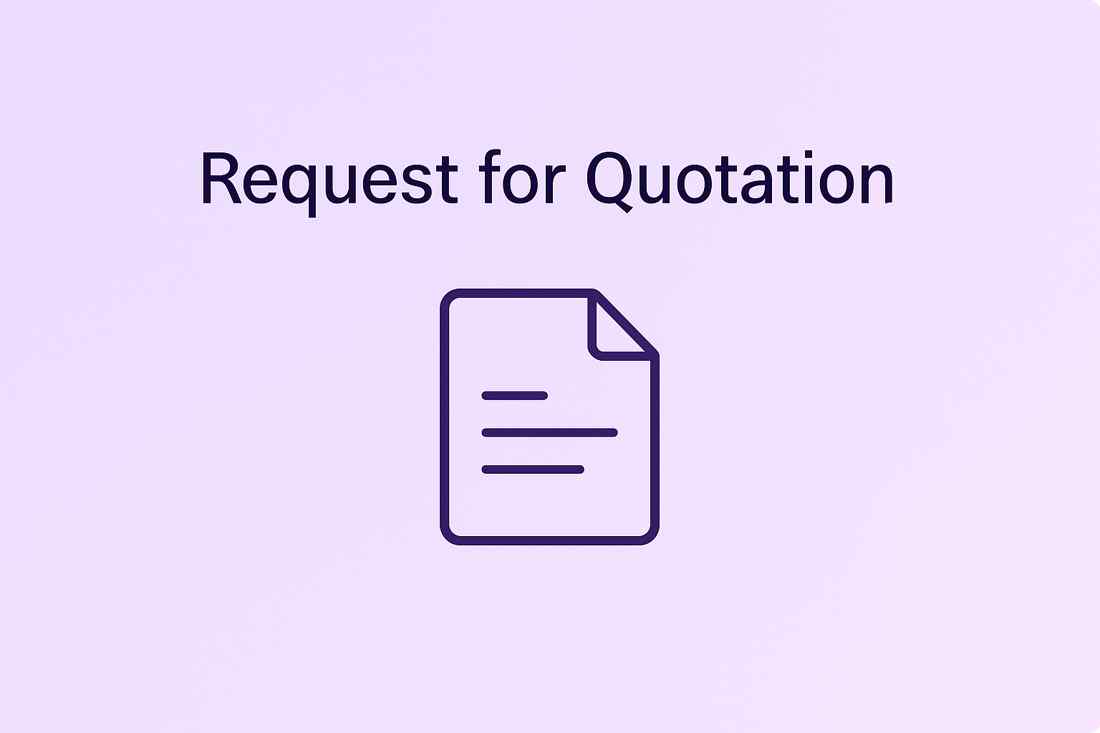What Is an RFQ (Request for Quotation)? Uses & Key Elements

What Is a Request for Quotation (RFQ)?
A Request for Quotation (RFQ) is a formal document that organizations use to solicit price quotes from vendors for specific goods or services.
RFQs are typically issued when product specifications, quantities, and delivery requirements are clearly defined—making price the primary factor in selecting a supplier.
Explore a full example in our blog: What Is an RFQ? Meaning, Use & Sample Template.
Purpose of an RFQ
The goal of an RFQ is to streamline procurement by allowing buyers to compare vendor pricing and terms for standardized needs.
RFQs are ideal for purchases that are transactional rather than strategic—such as office equipment, raw materials, or recurring supplies.
They help organizations:
- Obtain competitive pricing through multiple bids.
- Maintain transparency in supplier selection.
- Create a standardized evaluation process for easy comparison.
- Reduce procurement costs and time spent sourcing.
Learn how automation can simplify this process in Procurement Automation.
When to Use an RFQ
Use an RFQ when:
- Product or service specifications are precisely defined.
- Price is the main decision factor.
- You need to compare similar offerings from multiple vendors.
- The relationship is short-term or transactional.
Avoid using an RFQ for projects that require creativity, customization, or strategic alignment—these are better suited for a Request for Proposal (RFP).
RFQ vs. RFP vs. RFI
For a deeper breakdown, see our blog: RFQ vs RFP vs RFI: What’s the Difference?.
Key Elements of an RFQ Document
- Introduction – A short overview of the project and company background.
- Specifications – Detailed description of required goods or services.
- Quantity & Delivery – Required quantities, timelines, and shipping details.
- Submission Instructions – Guidelines on how and when vendors should submit bids.
- Evaluation Criteria – How bids will be scored and compared.
- Terms & Conditions – Payment terms, contract requirements, and legal details.
Download a sample layout in our post: What Is an RFQ? Meaning, Use & Sample Template.
Why RFQs Matter
A strong RFQ process ensures:
- Cost efficiency: Encourages competition to secure better pricing.
- Consistency: Creates a repeatable framework for future procurements.
- Accountability: Provides documentation for audit trails and compliance.
- Speed: Reduces time spent sourcing when specs are predefined.
RFQs also integrate seamlessly with Procurement Automation, allowing teams to send, track, and evaluate quotes automatically.
Best Practices for RFQ Management
- Keep requirements clear and measurable.
- Invite at least three vendors for competitive comparison.
- Standardize your RFQ template format.
- Follow up with vendors to clarify ambiguous details.
- Use automation tools like Iris Pro to manage submissions and evaluations.
Related: RFP Automation for SaaS Companies.
Frequently Asked Questions: Request for Quotation (RFQ)
What is the main difference between an RFQ and an RFP?
An RFQ (Request for Quotation) focuses primarily on price and quantity when requirements are clearly defined, while an RFP (Request for Proposal) evaluates broader factors like approach, quality, and fit for complex or strategic projects.
When should I issue an RFQ instead of an RFP?
Use an RFQ when you have exact specifications for a product or service and price is the main deciding factor. RFPs are better for projects that require customization, creativity, or strategic input.
What should be included in an RFQ?
A strong RFQ includes product or service specifications, quantity requirements, delivery timelines, submission instructions, evaluation criteria, and terms and conditions. These elements make it easy for vendors to provide clear and comparable bids.
Can RFQs be automated?
Yes. Platforms like Iris Pro automate RFQ creation, distribution, and evaluation — eliminating manual tracking, improving accuracy, and accelerating vendor selection through centralized workflows.
How many vendors should receive an RFQ?
Best practice is to invite at least three qualified vendors. This ensures competitive pricing, transparency, and a fair evaluation process without overwhelming your team with responses.
What happens after an RFQ is submitted?
After receiving responses, procurement teams evaluate bids based on price, delivery timelines, and compliance with requirements. Once the best supplier is identified, a purchase order or contract is issued to finalize the transaction.
Related Glossary Terms
Looking for more RFQ guides?
- RFQ vs RFP: Key Differences
- RFQ vs RFI: When to Use Each
- The Complete RFQ Process in 6 Steps
- RFQ Evaluation: Choosing the Best Supplier
- RFQ Automation: Tools & Best Practices
















